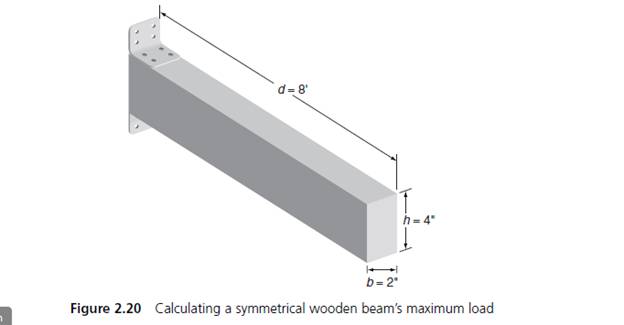
(Civil eng.) The maximum load that can be placed at the end of a symmetrical wooden beam, such as the rectangular beam shown in Figure 2.20, can be calculated as the following:
L is the maximum weight in lbs of the load placed on the beam.
S is the stress in lbs/in2.
I is the beam’s rectangular moment of inertia in units of in4.
d is the distance in inches that the load is placed from the fixed end of the beam (the
“moment arm”).
c is one-half the height in inches of the symmetrical beam.

For a 2” × 4” wooden beam, the rectangular moment of inertia is given by this formula:
a. Using this information, design, write, compile, and run a C++
maximum load in lbs that can be placed at the end of an 8-foot
the stress on the fixed end is
b. Use the program developed in Exercise 9a to determine the maximum load in lbs that can be placed at the end of a 3” × 6” wooden beam so that the stress on the fixed end is
Want to see the full answer?
Check out a sample textbook solution
Chapter 2 Solutions
C++ for Engineers and Scientists
 C++ for Engineers and ScientistsComputer ScienceISBN:9781133187844Author:Bronson, Gary J.Publisher:Course Technology Ptr
C++ for Engineers and ScientistsComputer ScienceISBN:9781133187844Author:Bronson, Gary J.Publisher:Course Technology Ptr Operations Research : Applications and AlgorithmsComputer ScienceISBN:9780534380588Author:Wayne L. WinstonPublisher:Brooks Cole
Operations Research : Applications and AlgorithmsComputer ScienceISBN:9780534380588Author:Wayne L. WinstonPublisher:Brooks Cole C++ Programming: From Problem Analysis to Program...Computer ScienceISBN:9781337102087Author:D. S. MalikPublisher:Cengage Learning
C++ Programming: From Problem Analysis to Program...Computer ScienceISBN:9781337102087Author:D. S. MalikPublisher:Cengage Learning- Programming Logic & Design ComprehensiveComputer ScienceISBN:9781337669405Author:FARRELLPublisher:CengageNp Ms Office 365/Excel 2016 I NtermedComputer ScienceISBN:9781337508841Author:CareyPublisher:Cengage





